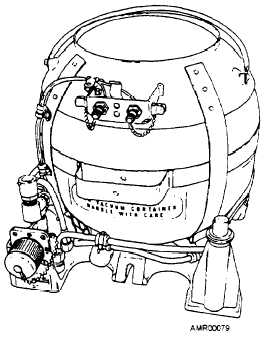contact area of the tire, causing it to wear faster at the
tread center. Failure due to carcass ruptures and breaks
in the tire cords that result from contact with foreign
objects are usually caused by overinflation.
Underinflation increases the contact area and causes
the tire to wear rapidly and unevenly at the outer edges
of the tread. An underinflated tire flexes excessively
and develops high temperatures that weaken tire cords.
An underinflated tire also may slip on the wheel during
landing and shear off the valve stem.
To determine the proper inflation pressure, you
should check an inflation chart like the one shown in
figure 5-6. If the gross weight of an aircraft is 20,000
pounds, the correct tire pressure for that aircraft when
shore based is 310 psi. If the aircraft is carrier based,
the pressure is maintained at 350 psi, regardless of the
gross weight. When aircraft tire pressure is low, you
should add air from a regulated source.
CAUTION
An unregulated, high-pressure air source
for tire inflation is a hazard. Tire inflation
source pressure should be carefully moni-
tored. If high-pressure cylinders (such as the
portable air bottle or the air or nitrogen serv-
icing trailer) are used, a regulator must be
used to prevent inadvertent overinflation.
Maintenance personnel must always use a remote
inflator unit when inflating tires. The operator of this
unit should always stand at right angles to the landing
gear axle, directly in front or in the rear of the tire. The
operator should also stand at the full length of the
inflator unit hose. This will prevent the operator from
being struck by pieces of the wheel if it were to fail
CAUTION
When an aircraft wheel is to be removed
from the aircraft, maintenance personnel must
deflate the tire before removing the wheel
assembly from the aircraft. This precaution is
necessary because of the possibility that the
bolts in split-type wheels might have been
sheared during landing, causing the wheel
halves to separate when the axle nut is re-
moved. Personnel have been killed because
they failed to remove the air from the tire
before removing the axle nut.
Oxygen Servicing
Plane captains are responsible for making sure that
the liquid oxygen systems of the aircraft are serviced.
Personnel in the Aviation Structural Mechanic, Safety
Equipment, (AME) rating refill these converters.
A typical liquid oxygen converter is shown in
figure 5-7. Liquid oxygen is dangerous to handle and
requires special handling procedures. These special
handling procedures are discussed later in this chapter.
SERVICING EQUIPMENT
The following text discusses the equipment used
to service aircraft, such as the high pressure air valve,
servicing trailers, preoiler hand pumps, and fluid
service unit HSU-1.
High-Pressure Air Valve
The high-pressure air valve is used to service
struts, accumulators, air storage bottles, and other
components serviced with high-pressure air. The
high-pressure air valve, shown in figure 5-8, is used
on most naval aircraft. It is referred to by its military
specification (MS) number MS 28889-1. Air valve MS
28889-1 does not have a valve core.
When servicing a system equipped with a
high-pressure air valve, you should exercise extreme
Figure 5-7.—Typical liquid oxygen converter.
5-12



